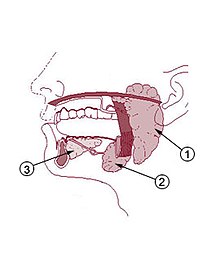Salivary gland
A salivary gland ( latin glandula salivaria ) is an exocrine gland that saliva ( saliva forms), thereby ensuring the slidability for Abschlucken the bite. In some mammals (humans, pigs) the saliva already contains starch-splitting enzymes ( amylases ), which means that the salivary glands contribute to digestion to a small extent .
In insects, the salivary gland is formed by the labial gland , which opens into a salivarium in front of the mouth opening.
Salivary glands of mammals
Classification
In the mammals , there are three major salivary glands :
- the parotid gland ( glandula parotidea or parotis ), which is purely serous, i.e. secretes a thin fluid secretion,
- the submandibular gland ( submandibular gland , in animals mandibular gland hereinafter) sero mixed in humans mucoid with a predominant proportion of serous end pieces, in most animals is mainly mucoid,
- and the sublingual salivary gland ( glandula sublingualis ), which is mixed muco-serous in humans with a predominant proportion of mucosal end pieces, in animals it is more serous.
In addition, there are numerous other small salivary glands in the wall of the oral cavity , which are named according to their location:
- Lingual tip gland ( glandula lingualis anterior , Blandin-Nuhn gland)
- Lip glands ( glandulae labiales )
- Cheek glands ( glandulae buccales )
- Tongue glands ( glandulae linguales )
- Molar glands ( glandulae molares )
- Palatine glands ( glandulae palatinae )
- Taste glands ( Glandulae gustatoriae ), flushing glands of the taste buds ( synonym Ebner glands )
Salivary gland diseases
In the larger salivary glands, pathological changes - e.g. B. a sialadenitis caused by salivary stones - can be clarified by means of ultrasound or a duct representation of the gland with an X-ray contrast medium .
Functional disorders
The flow of saliva ( sialorrhea ) is one of the functional disorders . The constant spitting out of saliva is called ptyalism . Salivation occurs as a symptom of various diseases. So with stomatitis , poisoning, acrodynia of children , stomach, pancreatic and esophageal diseases as well as neuroses and psychoses. The flow of saliva can also be increased during pregnancy and with neurological diseases. Reduced saliva secretion can occur with diabetes mellitus, kidney diseases, febrile infections, diseases of the central nervous system and diabetes insipidus , as a side effect after atropine administration , after major fluid losses (vomiting, diarrhea), with Mikulicz syndrome and with certain diseases of the salivary glands.
Inflammation
An inflammation of the salivary glands is also called Sialadenitis referred. The affected salivary gland swells painfully. If the ducts of salivary glands are ruptured, saliva flows into the surrounding tissues and saliva cysts can develop. One differentiates:
- Chronic active sialadenitis: It is a bacterially induced sialadenitis, caused by Staphylococcus aureus and Streptococcus viridans . Colonization is facilitated , for example, by a salivary stone. Chronic active sialadenitis is subdivided again into acute inflammation, chronic unspecific inflammation and chronic sclerosing inflammation (Küttner tumor).
- Autoimmune adenitis, see Sjogren's syndrome
- Inflammation of the parotid gland is called parotitis .
Salivary stone
Salivary stones ( sialolites ) can form in the ducts, which can lead to an infection with abscess formation due to the accumulation of secretions (see also: parotid gland disease ).
Tumors
A distinction is made between benign ( adenomas ) and malignant tumors ( adenocarcinomas ) of the salivary glands:
- Pleomorphic adenoma : the most common benign salivary gland tumor
- Warthin tumor : second most common benign salivary gland tumor
- A further distinction is made between a large number of malignant (malignant) tumors (salivary gland carcinomas), e.g. B. acinar cell carcinoma , mucoepidermoid carcinoma, adenoid-cystic carcinoma or adenocarcinoma-NOS (not otherwise specified).
- In Mikulicz syndrome there is a symmetrical swelling of the salivary and lacrimal glands.
Innate
Malformations are found in LADD syndrome , aplasia occurs in ALSG syndrome .
See also
literature
- Franz-Viktor Salomon: oral cavity, cavum oris. In: FV. Salomon et al. a. (Ed.): Anatomy for veterinary medicine . 2nd ext. Edition. Enke-Verlag, Stuttgart 2008, ISBN 978-3-8304-1075-1 , pp. 239-264.
- Hans Adolf Kühn: Diseases of the salivary glands. In: Ludwig Heilmeyer (ed.): Textbook of internal medicine. Springer-Verlag, Berlin / Göttingen / Heidelberg 1955; 2nd edition, ibid. 1961, pp. 750 f.
Web links
Individual evidence
- ↑ labial gland. In: Herder-Lexikon der Biologie. Spektrum Akademischer Verlag, Heidelberg 2003, ISBN 3-8274-0354-5 .
- ↑ Hans Adolf Kühn: Diseases of the salivary glands. 1961.
- ↑ G. Seifert: New pathohistologic WHO classification of salivary gland adenomas. In: The Pathologist. Volume 13, Number 6, November 1992, pp. 322-335, ISSN 0172-8113 . PMID 1454758 . (Review).
- ↑ Lacrimal and salivary gland aplasia. In: Orphanet (Rare Disease Database).
